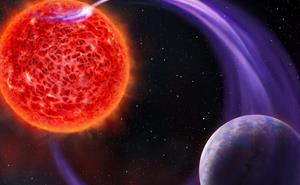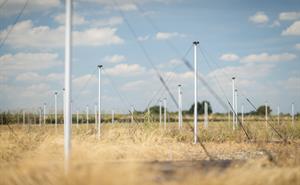The radio waves bear the tell-tale signature of aurorae caused by an interaction between a star and its planet. The radio emission from a star-planet interaction has been predicted for over thirty-years but this is the first time astronomers have been able to discern its signature. This method, only possible with a sensitive radio telescope like LOFAR, opens the door to a new way of discovering exoplanets in the habitable zone and studying the environment they exist in.
 Red dwarfs are the most abundant type of star in our Milky Way, but much smaller and cooler than our own Sun. This means for a planet to be habitable, it has to be significantly closer to its star than the Earth is to the Sun. Red dwarfs also have much stronger magnetic fields than the Sun, which means, a planet in the habitable zone around a red dwarf is exposed to intense magnetic activity. A huge current is generated when a planet moves through such a star's magnetic field, powering aurorae and radio emissions on the star which have now been detected by LOFAR.
Red dwarfs are the most abundant type of star in our Milky Way, but much smaller and cooler than our own Sun. This means for a planet to be habitable, it has to be significantly closer to its star than the Earth is to the Sun. Red dwarfs also have much stronger magnetic fields than the Sun, which means, a planet in the habitable zone around a red dwarf is exposed to intense magnetic activity. A huge current is generated when a planet moves through such a star's magnetic field, powering aurorae and radio emissions on the star which have now been detected by LOFAR.
Professor Glenn White, scientist at RAL Space and the Open University, one of the members of the study team said “This discovery has opened up an exciting new area in the study and characterisation of exoplanets. Understanding the likelihood for life to exist on planets orbiting the most common types of stars in our Galaxy is one of the most exciting topics in modern astronomy. Understanding this topic has profound implications about our origins in the Universe, and to the chances that we may not be alone. The revolutionary LOFAR telescope, operating at very low radio frequencies, provides a unique new view of the Universe around us, and was essential to the detection of the planet at GJ1151."
Thanks to the Sun's weak magnetic field and the larger distance to the planets, similar currents are not generated in the solar system. However, the interaction of Jupiter's moon Io with Jupiter's magnetic field generates a similarly bright radio emission, even outshining the Sun at sufficiently low frequencies. The team applied knowledge from decades of radio observations of Jupiter to understand the emission observed at GJ1151 the case of this star.
Nearly every red-dwarf star hosts terrestrial planets and so the group is now concentrating on finding similar emission from other stars. An effect from a star's magnetic field can heat the planet and even erode its atmosphere. The radio emissions associated with this process are one of the few tools available to gauge the potency of this effect. The group expects this new method of detecting exoplanets will open up a new way of understanding the space weather environment around exoplanets.
Dr Harish Vedantham, the lead author of the study and a Netherlands Institute for Radio Astronomy (ASTRON) staff scientist said, “The long-term aim is to determine what impact the star's magnetic activity has on an exoplanet's habitability, and radio emissions are a big piece of that puzzle. Our work has shown that this is viable with the new generation of radio telescopes, and put us on an exciting path."
RAL Space operates, manages and hosts one of the fifty-one telescopes that make up the pan-European LOFAR telescope array at its Chilbolton Observatory in Hampshire.

Images
Top: Artist impression of a red-dwarf star’s magnetic interaction with its exoplanet. Credit: Danielle Futselaar (artsource.nl)
Bottom: LOFAR telescope array at Chilbolton. Credit: Theo Moye.
Paper link
'Coherent radio emission from a quiescent red dwarf indicative of star–planet interaction' is published in Nature Astronomy on 17 February 2020: https://www.nature.com/articles/s41550-020-1011-9
DOI: https://doi.org/10.1038/s41550-020-1011-9
